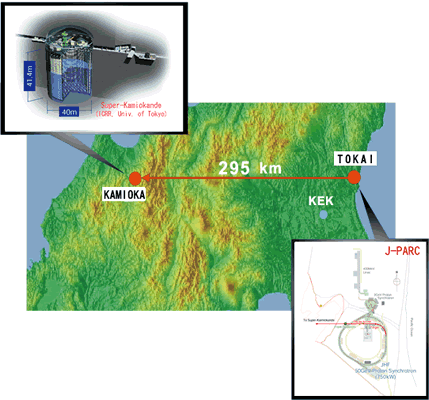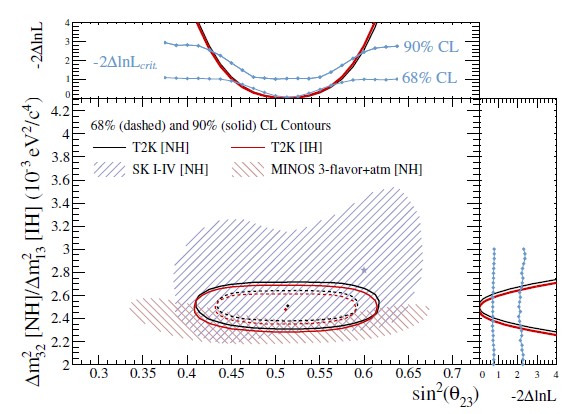Sheffield T2K Group
11th November 2014 : Takashi Kobayashi and Tsuyoshi Nakaya awarded the Nishina Memorial Prize for the discovery of electron neutrino appearance in a muon neutrino beam.
 The T2K experiment is a second generation neutrino oscillation
experiment using the existing Super-Kamiokande
experiment as the far
detector. A muon-neutrino beam is produced by directing the
protons from a high-power 30 GeV proton synchrotron at the
J-PARC nuclear physics
facility at Tokai on the east coast of Japan on to a graphite target
designed by UK physicists. A novel feature of the T2K experimental
setup is that the beam is deliberately aimed 2.5° off the direct
line to Super-K: this off-axis configuration produces a much more
monochromatic beam, and the 2.5° angle was chosen to maximise
the oscillation probability.
The T2K experiment is a second generation neutrino oscillation
experiment using the existing Super-Kamiokande
experiment as the far
detector. A muon-neutrino beam is produced by directing the
protons from a high-power 30 GeV proton synchrotron at the
J-PARC nuclear physics
facility at Tokai on the east coast of Japan on to a graphite target
designed by UK physicists. A novel feature of the T2K experimental
setup is that the beam is deliberately aimed 2.5° off the direct
line to Super-K: this off-axis configuration produces a much more
monochromatic beam, and the 2.5° angle was chosen to maximise
the oscillation probability.
The primary aim of the T2K experiment, achieved in 2011 with the publication of the paper Indication of Electron Neutrino Appearance from an Accelerator-produced Off-axis Muon Neutrino Beam[1], was the measurement of the mixing angle θ13, which at the time that T2K was constructed was the only unmeasured angle in the PMNS matrix. This measurement has since been refined with more data[2], and is by far the most precise such measurement in the νμ → νe channel (reactor neutrino experiments such as Daya Bay measure disappearance of the electron antineutrino). Comparisons of the T2K result with those from reactor experiments provides the first hint that δCP ≠ 0; this exciting suggestion will be followed up with more data.
Because of the similarity of the mass differences Δm213 and
Δm223, any νμ experiment optimised for
measurement of θ13 is also optimised for measuring θ23
via the νμ disappearance channel, so another of T2K's primary goals
was the improvement of the measurement of the (23) mixing parameters. The 2014 result[3]
is shown in the figure, and demonstrates that the T2K analysis is now world leading.

The neutrino oscillation results could not be achieved without good control of systematic errors. The T2K near detector, ND280, located on the J-PARC site 280 m from the target, is an essential part of this. Its tasks are to characterise the unoscillated beam, including its profile, energy spectrum and intrinsic νe component, to improve our understanding of neutrino-nucleus interactions, and to measure any specific processes that contribute to oscillation backgrounds – particularly the production of π0s, which can be mistaken for electrons in Super-K. Most of the work of the Sheffield group has focused on ND280 physics.
T2K in the UK
The T2K UK Collaboration consists of groups from Daresbury Laboratory, Imperial College, Lancaster, Liverpool, Oxford, Queen Mary, RAL, Sheffield and Warwick. The UK group designed the target and beam dump, the ND280 data acquisition and much of the electronics, and built the ND280 electromagnetic calorimeter (ECal). Sheffield's contribution included the testing and evaluation of MPPC photosensors, quality assurance and testing of all the ECal scintillator bars, and the design and development of a light injection system for calibration purposes. The group also played a leading role in the optimization studies that led to the final design of the so-called P0D ECal, the electromagnetic calorimeters surrounding the central pi-zero detector.
Choose one of the links above to learn more about the activities of the Sheffield T2K group.
References
- T2K Collaboration, PRL 107 (2011) 041801 (arXiv:1106.2822 [hep-ex]).
- T2K Collaboration, PRL 112 (2014) 061802 (link to PRL article – free to download).
- T2K Collaboration, PRL 112 (2014) 181801 (arXiv:1403.1532 [hep-ex]).

